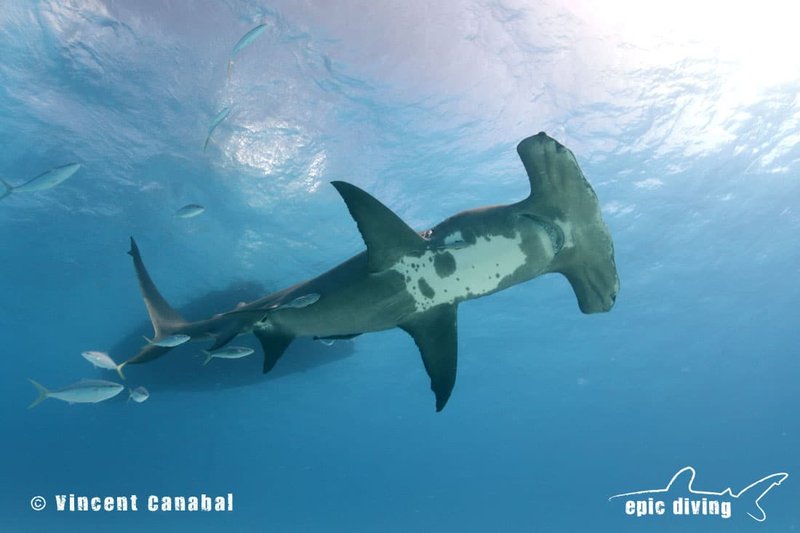
It’s like peering into a living time capsule, where each generation carries a piece of the ocean’s history. Picture it: the hammerhead has been swimming through our oceans for over 20 million years. That’s a long time, right? During this time, they’ve adapted to changing environments, outlived various extinction events, and developed remarkable traits that set them apart not just from other sharks, but from many marine animals altogether. Let’s dive into this evolutionary adventure and see what makes hammerhead sharks so special.
What Are Hammerhead Sharks?
Hammerhead sharks belong to the family Sphyrnidae, and there are several species, the most well-known being the great hammerhead (*Sphyrna mokarran*). They have a unique head structure called a cephalofoil, which gives them their characteristic shape. This unusual design is not just for show; it plays a significant role in their hunting and navigation.
The cephalofoil helps hammerheads to better sense their environment. It enhances their electrosensory abilities, allowing them to detect the electric fields produced by potential prey. Imagine having a superpower that lets you feel your food from a distance—pretty cool, right? Besides this, their wide-set eyes provide a broader field of vision, helping them spot predators and prey more efficiently.
Visually, hammerhead sharks can grow quite large, with some species reaching up to 20 feet in length. Their bodies are typically streamlined for speed, and their coloration can range from a sandy brown to a more bluish grey. This coloration helps them blend into the ocean floor, making them stealthy predators.
The Hammerhead Shark’s Ancestors
To understand the hammerhead’s evolution, we need to look back in time. The ancestors of modern sharks date back to over 400 million years ago, during a period known as the Devonian, often referred to as the “Age of Fishes.” Hammerhead sharks, specifically, first started to appear in the fossil record around 20 million years ago during the Miocene epoch.
These early hammerheads were quite different from the ones we see today. For instance, fossils show that they had even larger and more pronounced hammer-like heads. Over millions of years, they adapted to changing environments, leading to the diverse range of hammerhead species we have now.
Interestingly, the evolutionary path of hammerheads reflects broader changes in the ocean. As environmental conditions changed—like shifts in sea levels and temperature—so too did the hammerhead sharks. They adapted to various prey availability and competition, which helped them survive where other species might have failed.
Unique Adaptations of Hammerhead Sharks
One of the standout features of hammerhead sharks is their ability to hunt effectively due to their unique adaptations. Their bulbous heads, or cephalofoils, are designed to gather sensory information and help them locate prey with unparalleled precision.
Another significant adaptation is their strange social behavior. Unlike many shark species that are solitary, some hammerheads are known to gather in schools, particularly during mating season. These schools can consist of dozens, sometimes even hundreds, of individuals. Imagine a group of friends going on a hunting trip together—it’s a cooperative approach that increases their chances of success.
Additionally, hammerhead sharks display a fascinating behavior called “conductivity sensing.” Their heads are lined with special organs called ampullae of Lorenzini, which can detect electrical signals in the water. This is incredibly useful for hunting, especially when prey is hiding under sand or in rocky crevices.
The Role of Hammerhead Sharks in the Ecosystem
Hammerhead sharks play a crucial role in their ecosystem. As apex predators, they help maintain a balance in marine environments. By keeping populations of smaller fish and other marine animals in check, they ensure that ecosystems remain healthy and diverse.
You might be wondering why this matters. Healthy oceans are essential for the overall health of the planet. They contribute to global oxygen production, climate regulation, and food supply for millions of people. By protecting hammerhead sharks and their habitats, we’re also supporting the entire ocean ecosystem.
However, hammerhead populations are declining due to overfishing, habitat loss, and climate change. Many species are now endangered, meaning that protecting them has become even more critical. It’s a stark reminder of how interconnected our environment is and how the loss of one species can have ripple effects throughout the ecosystem.
The Future of Hammerhead Sharks
So, where do hammerhead sharks go from here? The future is uncertain, but conservation efforts are underway in many parts of the world. Marine protected areas and fishing regulations are helping to safeguard their habitats and improve their chances of survival.
Many organizations are dedicated to studying hammerhead sharks and spreading awareness about their importance. This research is vital for understanding their behavior, migration patterns, and breeding habits, which in turn aids in the development of effective conservation strategies.
As the world evolves, the hammerhead shark continues to adapt, but it will need our help to thrive. Supporting sustainable fishing practices, reducing pollution, and protecting marine habitats are just a few ways we can make a difference.
The evolutionary journey of the hammerhead shark is a remarkable story of adaptability and survival. From their ancient ancestors to their unique adaptations, hammerheads have shown incredible resilience throughout millions of years.
As we continue to learn about these fascinating creatures, we also recognize the need to protect them. After all, every creature in the ocean, from the smallest plankton to the largest hammerhead, plays a vital role in the delicate balance of marine life. By understanding and appreciating the hammerhead shark, we can help ensure that it remains a part of our oceans for generations to come. So next time you think of sharks, remember the hammerhead and the incredible journey it represents.

